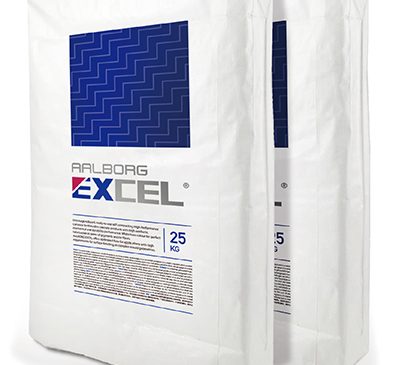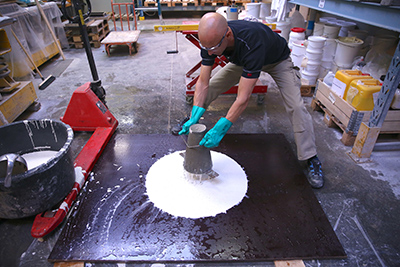Lehigh White Cement Co. is helping to drive sustainable development and resilient design through the patented Futurecem binder technology of parent company, Cementir Holding, Italy. Sourced without the supply constraints, increasing scarcity and volatile pricing often accompanying outside industries’ byproducts, Futurecem represents a potential 50 percent carbon dioxide emissions reduction over conventional portland cement concrete without sacrificing performance. The technology also supports two low-shrinkage architectural Ultra High-Performance Concrete (UHPC) dry mix products now available in North America: Aalborg Excel and Extreme Light 120. Both are part of Cementir’s InWhite Solutions series.




What’s special about UHPC? The material is typified by extremely high compressive strengths, exceptional durability and, when combined with high strength fibers, the ability to withstand bending without the brittle failure associated with conventional concrete. Depending on who you ask, the lower limit in compressive strengths for a concrete mixture to be considered UHPC is 120 MPa (17,400 psi). Indeed, many UHPC mixtures reach compressive strengths of 150 to 250 MPa (22,000-36,000 psi). Tensile strengths of these products reach 6 to 9 MPa (900-1,700 psi) compared to conventional concrete’s tensile strength of only 1 to 3 MPa (150-440 psi)1. With the right fibers, typically making up around 2 percent of mixture volume, UHPC will stand up to tensile loads by conceding a prolonged succession of very small cracks yielding a ductile, flexural response to the stress2. They will essentially bend before they break.
MIX MECHANICS
How do UHPC mixtures work? By and large they have a much higher percentage of paste and rely solely on fine aggregates within the mortar or concrete matrix. In fact, one way to think about UHPC is to envision making a high powder concrete with a densely packed assembly of materials down to the micron and sub-micron level with fine aggregate, sand at the top end of the scale. By increasing the volume and reactivity of the paste portion of the mix these materials become highly flowable and extremely dense with especially low permeability characteristics. The portland cement grades in these concretes are often near the top of the fineness scale for the cementitious binders contained in a given mixture. Physical performance and mechanical properties make this class of materials ideally suited for thin sections and geometrically complex, architectural or structural profiles. This in turn results in net conservation of materials, a proven strategy in sustainable design.
What’s special about Lehigh White Cement’s new products? Aalborg Excel and Extreme Light 120 have wide application as low-shrinkage, architectural, preblended UHPC mixtures. They are packaged complete with binders, admixtures and graded fine aggregates; when mixed with the prescribed water and specialty fibers, they yield a white concrete with ultra-high compressive and tensile strengths, plus very low permeability. Aalborg Excel and Extreme Light 120 produce highly flowable mortar whose unusually “light” white color is well suited for use in architectural applications or where exposed structural concrete requires an aesthetic component. These mixtures are readily pigmented and can be combined with locally sourced aggregates to match or complement conventional architectural finishes3.
How will availability lead to innovation? “Our white cement customers on the whole are extremely innovative and technically astute concrete producers. They constantly push the boundaries of what can be produced,” says Lehigh White Account Manager Larry Rowland, who is responsible for the Aalborg Excel and Extreme Light 120 rollout in North America. “I look forward to seeing how this talented group of people use our UHPC products to make concrete that is durable, resilient, environmentally efficient, and architecturally interesting. The interest from the engineering and design communities is very high. I truly believe this material is a game changer for our industry.”
The products differ from other UHPCs on a key aspect, he adds: Based on Futurecem technology, they do not rely on silica fume or finely ground silica flour. Excluding such ingredients commonly found in UHPC mixtures makes Aalborg UHPC ideal for use in jurisdictions where practitioners do not want to rely on a waste stream from other industries or have strict color consistency requirements. — Lehigh White Cement Co. LLC, West Palm Beach, Fla., www.lehighwhitecement.com
1 Graybeal B. A., Crane C. K., Perry V., Corvez D., and Ahlborn T.M., “Advancing Ultra-High-Performance Concrete, ACI Committee 239 convenes experts to deliver strategic advancements.” Concrete International, April 2019, pp. 41-45.
2 Graybeal, B. Material Property Characterization of Ultra-High Performance Concrete. FHWA-HRT-06-103. FHWA, U.S. Department of Transportation, 2006.
3 Batista C. M.Q., Rowland L. and Nielsen E.P., The Next Generation of UHPC, 2nd International Interactive Symposium on UHPC, Albany, June 2019